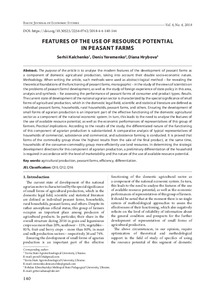Please use this identifier to cite or link to this item:
http://elar.tsatu.edu.ua/handle/123456789/6405Full metadata record
| DC Field | Value | Language |
|---|---|---|
| dc.contributor.author | Kalchenko, Serhii | - |
| dc.contributor.author | Кальченко, Сергій Володимирович | - |
| dc.contributor.author | Кальченко, Сергей Владимирович | - |
| dc.contributor.author | Yeremenko, Denys | - |
| dc.contributor.author | Єременко, Денис Володимирович | - |
| dc.contributor.author | Еременко, Денис Владимирович | - |
| dc.contributor.author | Hrybova, Diana | - |
| dc.date.accessioned | 2019-04-03T08:23:47Z | - |
| dc.date.available | 2019-04-03T08:23:47Z | - |
| dc.date.issued | 2018 | - |
| dc.identifier.other | DOI: 10.30525/2256-0742/2018-4-4-140-144 | - |
| dc.identifier.uri | http://elar.tsatu.edu.ua/handle/123456789/6405 | - |
| dc.description.abstract | The purpose of the article is to analyse the modern features of the development of peasant farms as a component of domestic agricultural production, taking into account their double socio-economic nature. Methodology. When writing the article, such methods were used as abstract-logical method – for revealing the theoretical foundations of the functioning of peasant farms, monographic – in the study of the views of scientists on the problems of peasant farms’ development, as well as the study of foreign experience of state policy in this area, analysis and synthesis – for assessing the performance of peasant farms of consumer and product types. Results. The current state of development of the national agrarian sector is characterized by the special significance of small forms of agricultural production, which in the domestic legal field, scientific and statistical literature are defined as individual peasant farms, households, rural households, peasant farms, and others. Ensuring the development of small forms of agrarian production is an important part of the effective functioning of the domestic agricultural sector as a component of the national economic system. In turn, this leads to the need to analyse the features of the use of available resource potential, as well as the economic performances of representatives of this group of farmers. Practical implications. According to the results of the study, the differentiated nature of the functioning of this component of agrarian production is substantiated. A comparative analysis of typical representatives of households of commercial, subsistence and commercial, and subsistence farming is conducted. It is proved that farms of the commodity group show the highest results from the sale of the final product, at the same time, households of the consumer-commodity group more efficiently use land resources. In determining the strategic development directions for this component of agrarian production, a preliminary differentiation of the household is required in accordance with the level of marketability and the nature of the use of available resource potential. | uk |
| dc.language.iso | en | uk |
| dc.relation.ispartofseries | Baltic journal of economic studies;T. 4, vol. 4 (P. 140-144) | - |
| dc.subject | agricultural production | uk |
| dc.subject | peasant farms | uk |
| dc.subject | efficiency | uk |
| dc.subject | differentiation | uk |
| dc.title | Features of the use of resource potential in peasant farms | uk |
| dc.type | Article | uk |
| Appears in Collections: | Кафедра Економіки і бізнесу | |
Files in This Item:
| File | Description | Size | Format | |
|---|---|---|---|---|
| 491-547-1-PB.pdf | 127.36 kB | Adobe PDF |  View/Open |
Show simple item record
CORE Recommender
???jsp.display-item.check???
Items in DSpace are protected by copyright, with all rights reserved, unless otherwise indicated.
